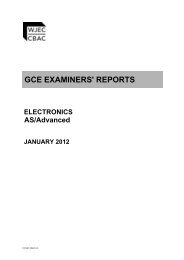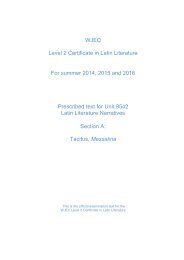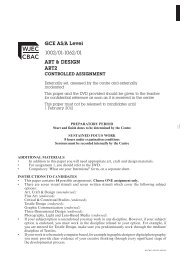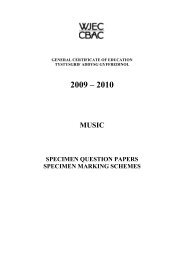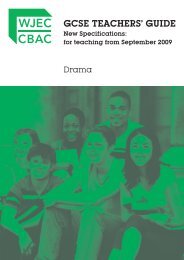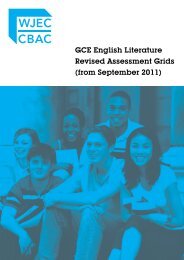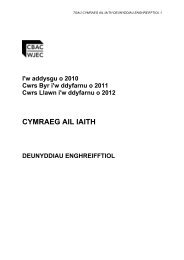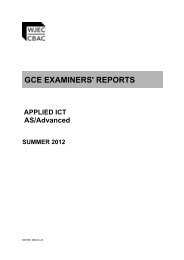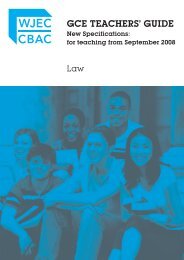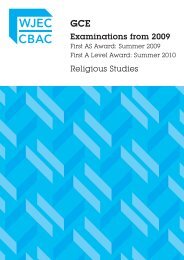WJEC ENGLISH LITERATURE
WJEC ENGLISH LITERATURE
WJEC ENGLISH LITERATURE
Create successful ePaper yourself
Turn your PDF publications into a flip-book with our unique Google optimized e-Paper software.
Principal Moderator’s Comments<br />
Creative Writing Response: A Lynching – 20 th October 1894<br />
AO1 This is a creative response to the selected Faulkner short story in the way that the<br />
student has tried to go beyond the stimulus text by finding different viewpoints and different<br />
voices with which to treat the subject. The poem is carefully structured in six parts: part I<br />
setting the scene; part II giving the black man’s view-point; part III, the female accuser’s; part<br />
IV the lynch mob’s leader; part V, the bystander’s, caught up in the frenzy; and part VI,<br />
imaginatively giving the final part, the death, to the rope. On the whole, this works well and is<br />
effective because the different parts have been given distinctive forms and voices. Individual<br />
parts are also thoughtfully structured. For example, part I prepares the reader for the<br />
lynching by the repetition of the negatives and the contrasting section beginning with<br />
‘Instead’. The shocking nature of what is to come is underlined by the effective images made<br />
of casual words in the next verse, words such as ‘twist in their hands’, ‘kept in pockets’ and<br />
‘thrown around/like rolling dice’. Perhaps the play on eyes and moral blindness in the last<br />
verse of this section is more clumsily handled. Mostly the writer has a good sense of line,<br />
uses repetition effectively and some of the descriptions are especially vivid e.g. ‘under the<br />
spotted sky of ebony’. There are places where the writing is not so controlled; the last four<br />
lines of part III, for example, come close to doggerel – though the commentary attempts to<br />
justify this. The ending of the poem is very thoughtful; the rope as a parting lover, the<br />
shortening lines and then the quiet repetition of the opening line of this part. In places there<br />
is surely a degree of sophistication in the use of structure, form and language. Band 4<br />
17/20<br />
Commentary<br />
AO2 There is sound analysis and some evaluation of structure, form and language;<br />
however, the emphasis is on structure and form and it would have been useful to have had a<br />
little more close analysis of the effects of language. Although the claim is that the stimulus<br />
te xt inspired the response’s subject matter, there are also a few useful references to certain<br />
features of the stimulus text and the ways in which they have affected the style and narrative<br />
approaches of the poem. Band 4<br />
AO4 This student refers to one Faulkner story whereas we would expect reference to more<br />
than one story. This approach limits discussion of the context of the stimulus text which is<br />
barely touched on in the commentary. Nevertheless, there is some discussion of the<br />
contextual influence of ‘Dry September’ and mention made of an influential newspaper<br />
article. What other ideas influenced the attitudes and intentions of the poem are only briefly<br />
touched on. And it would have been interesting to learn why someone who calls herself<br />
‘usually a prose writer’ chose this long poem form. Generally, this commentary addresses<br />
AO2 effectively but pays less attention to AO4.<br />
Low Band 3<br />
Commentary mark 15/20<br />
Final Mark 32/40 Low Band 4<br />
28



